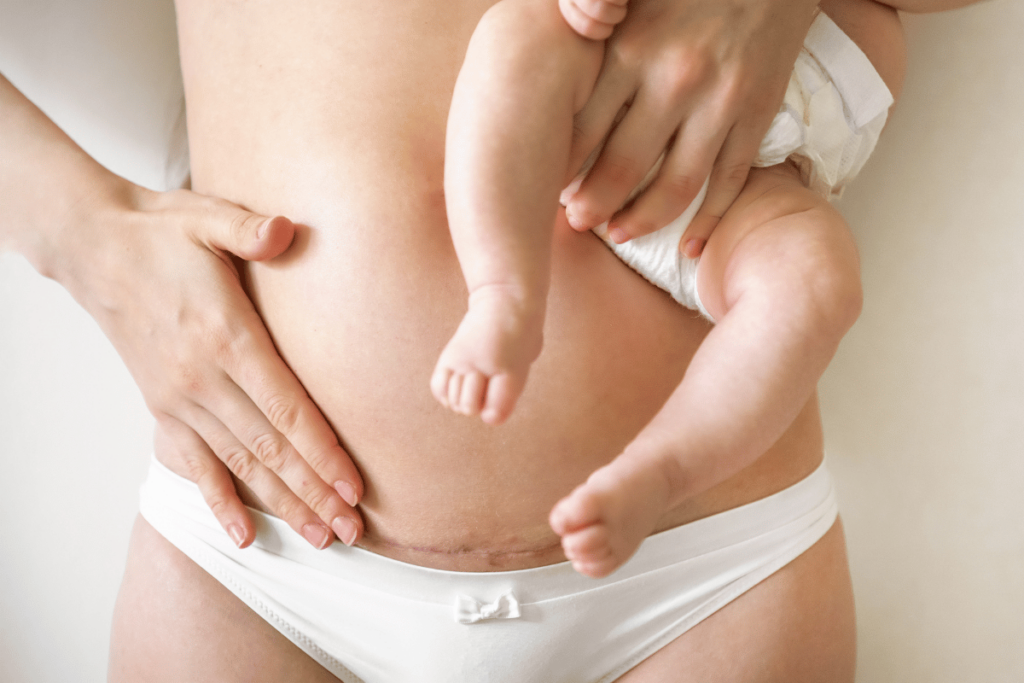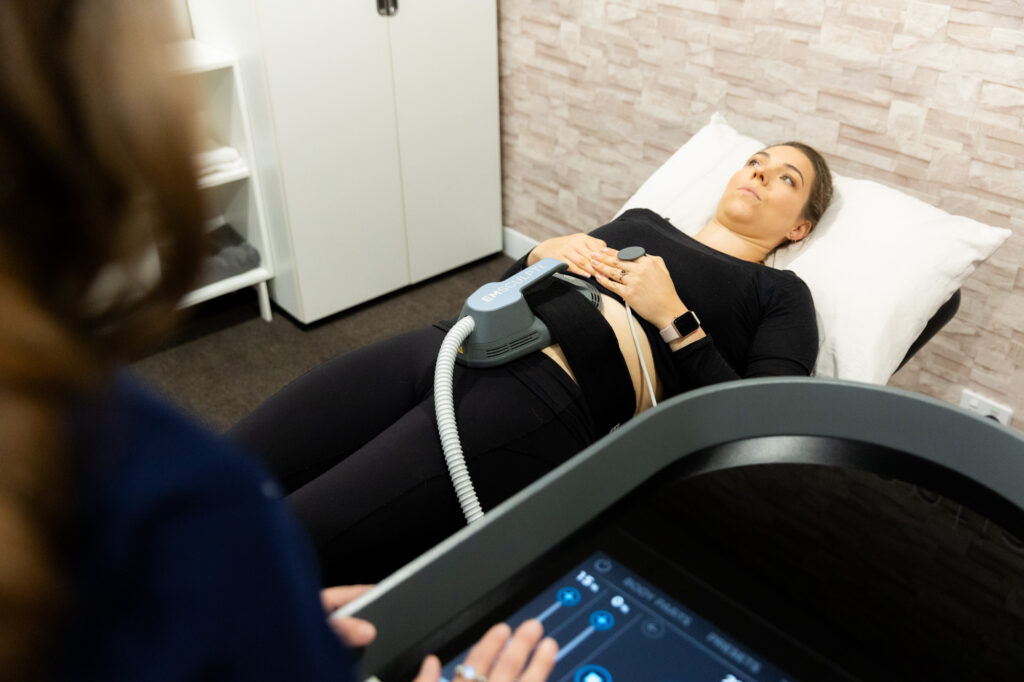News
Reconnecting core strength: Understanding and treating abdominal separation after pregnancy
Pregnancy is a transformative journey for the body, but along with the joy of bringing new life comes several physical changes that many women don’t anticipate. One of the most common issues experienced by women during and after pregnancy is abdominal separation, known medically as diastasis recti. This condition can have long-term effects on core strength, posture, and overall well-being if left untreated.
In this blog, we will explore abdominal separation, why it happens, and how to restore core strength, with practical solutions offered at our medi spa in Perth and our Performance Pilates & Physiotherapy studios.
Are you experiencing abdominal separation after pregnancy? Book a consultation with us to learn more about how we can help.
What is Abdominal Separation (Diastasis Recti)?
Abdominal separation, or diastasis recti, occurs when there is a widening between the right and left sides of the rectus abdominis muscles (commonly known as the “six-pack” muscles). This happens due to the stretching of the connective tissue, called the linea alba, which connects these muscles. The most common cause of diastasis recti is pregnancy, where the growing baby stretches the abdominal wall, leading to separation.
This separation is entirely natural during pregnancy but, for some women, it doesn’t fully heal postpartum, leading to symptoms such as:
- A visible bulge or pooch in the middle of the abdomen
- Lower back pain
- Poor posture
- Weakness of the abdominal core muscles
- Difficulty lifting objects or performing daily tasks
You may also like Bridging the gap: Understanding ab separation
Why does ab separation happen during and after pregnancy?
The primary reason for diastasis recti during pregnancy is the expansion of the uterus, which pushes against and stretches the abdominal wall. Hormonal changes, particularly the increase in relaxin and oestrogen, soften the connective tissues such as the linea alba and make it easier for the abdomen to stretch. (1)(2) Several factors can contribute to the severity of diastasis recti, including:
- Multiple pregnancies: Successive pregnancies can increase the likelihood of abdominal separation.
- Carrying large babies: A larger baby can stretch the abdominal muscles more.
- Age: Older mothers are more susceptible to diastasis recti.
- Incorrect or lack of appropriate prenatal core strengthening: Engaging the abdominals or core strengthening exercises during pregnancy can exacerbate the condition so consulting a Women’s Health Physiotherapist is recommended for optimal advice.

Postpartum abdominal separation: What to expect
After pregnancy and childbirth, it is normal for women to experience some level of abdominal separation. In some cases, the muscles naturally come back together over time, especially with appropriate postpartum care. However, in other cases, the separation remains, which can lead to discomfort and mental health challenges related to changes in appearance.
If left untreated, postpartum diastasis recti can contribute to:
- Chronic back pain
- Digestive issues
- Persistent abdominal weakness leading to a loss of core strength
How to identify Diastasis Recti
One of the simplest ways to check for diastasis recti is by performing a self-assessment:
- Lie on your back with your knees bent and feet flat on the floor
- Place one hand on your abdomen, with your fingers pointing down towards your belly button
- Gently lift your head and shoulders off the floor as if performing a crunch
- Using your fingers, feel for any gaps between the muscles above or below the belly button
- A separation of more than 2-2.5 finger widths (2cm) between the rectus abdominis muscle bellies is called the ‘inter-recti distance’, a sign of diastasis recti.
- ‘Doming’ of the linea alba in the chest lifted crunch position may also indicate there is an abdominal separation.
If you are unsure or want a professional diagnosis, it’s always best to consult a women’s health physiotherapist. They will determine whether you have abdominal diastasis by checking and measuring the distance between the rectus abdominis muscles using calipers or Trans-abdominal Ultrasound.
Treating abdominal separation after pregnancy
Essential Alchemy, a holistic medi spa in Perth, specialises in restoring core strength and treating postpartum issues like diastasis recti. Here are some of the most effective approaches to reconnecting your core:
Physiotherapy for abdominal separation
Physical therapy is one of the most effective treatments for abdominal separation. A trained physiotherapist will design a program specifically aimed at restoring your core strength, focusing on:
- Strengthening the deep core muscles: The transverse abdominis is the deepest layer of abdominal muscles and plays a crucial role in core stability. Targeted exercises can help bring the rectus abdominis muscles back together.
- Safely strengthening the abdominal exercises: Under the guidance of a Women’s Health Physiotherapist, specific exercises targeting the Rectus Abdominis and abdominal obliques can be implemented to be appropriate for the post-partum period while being safe for pelvic floor recovery. Abdominal muscle strengthening post-partum is best performed in conjunction with abdominal binding. (3)
- Posture correction: Poor posture can worsen diastasis recti, so posture-correcting exercises are an important part of any treatment plan.
- Breathing exercises: Learning to engage your core muscles through proper breathing techniques can support healing.
We provide tailored physiotherapy for abdominal separation at our Performance Pilates & Physiotherapy studios in Leederville and South Perth.

Pilates for postpartum core strength
Pilates, known for its focus on core control and muscle alignment, is highly effective in treating abdominal separation. Pilates exercises can:
- Strengthen the pelvic floor: A strong pelvic floor is key to overall core strength, helping to reduce the gap in the abdominal wall.
- Engage the deep core: Pilates moves are often tailored to focus on engaging the deep core muscles without placing undue strain on the rectus abdominis.
- Rebuild abdominal muscle tone and physique: Strengthen the Rectus Abdominis and abdominal oblique muscles to regain strength and confidently return to the activities you enjoy.
Performance Pilates offers customised Pilates sessions that are specifically designed for women recovering from childbirth. Book one of our Pregnancy and Beyond Pilates Classes today.
Emsculpt NEO: A revolutionary non-invasive treatment
Emsculpt NEO is an innovative, non-invasive treatment that uses a combination of high-intensity focused electromagnetic energy (HIFEM) and radiofrequency (RF) technology to strengthen and tone muscles. By targeting both fat reduction and muscle growth, Emsculpt NEO is
highly effective for postpartum women seeking to restore core strength and address diastasis recti. This treatment can help tighten the abdominal muscles without the need for surgery or downtime.
At Essential Alchemy, Emsculpt NEO sessions are tailored to your specific needs, helping you regain core stability and overall strength after pregnancy.
Want to try out our Emsculpt NEO treatment? Book a free consultation today.

Lifestyle adjustments
Certain lifestyle changes can also help in the treatment and prevention of abdominal separation:
- Avoid heavy lifting: Lifting heavy objects can place unnecessary strain on the abdominal muscles.
- Wear supportive garments: Postpartum belts or garments for abdominal binding can offer support to your healing muscles and promote better posture. Consult a Women’s Health Physiotherapist to fit you with an appropriate binder or support garment. (3)
- Maintain a healthy weight: Excess weight can strain the abdominal muscles and slow down the healing process.
Reconnect with your core at Essential Alchemy
At Essential Alchemy, we believe that every woman deserves to feel strong and confident in her body after pregnancy. Our range of treatments, from personalised physical therapy to non-invasive Emculpt NEO sessions, are designed to help you reconnect with your core and regain control over your body.
Book a consultation today and let us guide you on your journey to healing and strength.
Contact Us
Frequently asked questions
How long does it take for abdominal separation to heal after pregnancy?
The healing process varies for every woman. Mild cases of diastasis recti may resolve on their own within 6-8 weeks postpartum, while more severe cases can take several months of focused therapy. For some women, medical treatment may be needed to achieve full recovery.
Can I prevent abdominal separation during pregnancy?
While it’s not always possible to prevent diastasis recti, you can reduce your risk by engaging in prenatal exercises that focus on deep core and pelvic floor strength. Avoid exercises that place excessive pressure on the abdominal muscles, such as traditional crunches, and heavy lifting. A Women’s Health Physiotherapist is your best resource to ensure that you are exercising safely and appropriately.
Is surgery required to fix diastasis recti?
Surgery is only necessary in very severe cases where physical therapy and other treatments have not been effective.
When should I start postpartum exercises for diastasis recti?
It’s important to consult your doctor and a Women’s Health Physiotherapist before starting any postpartum exercise routine. In general, gentle core exercises can begin within a few weeks after childbirth in conjunction with abdominal binding (3), but more intensive exercises should wait until at least six weeks postpartum, or until you have been cleared by your healthcare provider.
References:
- Keshwani N, Mathur S, McLean L. Relationship between interrectus distance and symptom severity in women with diastasis recti abdominis in the early postpartum period. Phys Ther. 2018 Mar ;98(3):182-90. doi: 10.1093/ptj/pzx117
- Chen MH, Hu CK, Chen PR, Chen YS, Sun JS, Chen MH. Dose-dependent regulation of cell proliferation and collagen degradation by estradiol on ligamentum flavum. BMC Musculoskeletal Disord. 2014 Dec; 15(1):1-0. doi: 10.1186/1471-2474-15-238
- Keshwani N, Mathur S, McLean L. The impact of exercise therapy and abdominal binding in the management of diastasis recti abdominis in the early post-partum period: a pilot randomised controlled trial. Physiotherapy Theory and Practice. 2019 Oct 25:1-6.
